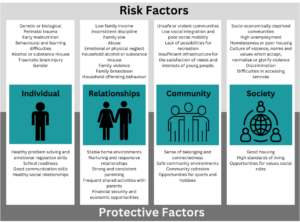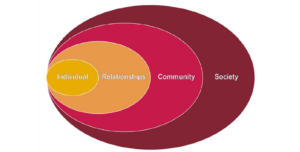What is serious violence
The Serious Violence Duty does not set out a national definition of serious violence. It states that authorities must work together to identify the kinds of serious violence that occur in their area, so that the different areas and types of crime that occur are reflected.
The agreed definition of serious violence for Hampshire, Isle of Wight, Portsmouth and Southampton is:
- Most serious violence – Grievous Bodily Harm and above.
- Robbery
- Possession of a weapon offences
- Public order – violent disorder and riot
- Any violence with injury where a bladed implement was used.
Violence Against Women and Girls (VAWG) and domestic abuse crimes are not included in the definition, it has been decided that there is already strategic focus and governance on these crime types across the Hampshire, Isle of Wight, Portsmouth and Southampton area. This includes the Hampshire and Isle of Wight VAWG Task Group, Portsmouth Domestic Abuse Strategy and Southampton Domestic Abuse and VAWG Strategy. The decision is also in line with the primary Violence Reduction Unit focus on violence by under 25s in public places.
Hampshire, Isle of Wight, Portsmouth and Southampton have agreed the following list of all offences included within the definition of serious violence.
| Murder of persons age one year or over; genocide or crime against humanity |
| Murder of persons under one year of age |
| Manslaughter |
| Infanticide |
| Attempted murder; attempted genocide or crime against humanity |
| Causing death by aggravated vehicle taking |
| Causing serious injury by dangerous driving |
| Causing death by dangerous driving without due care/ consideration over prescribed limit specified controlled drug |
| Child destruction |
| Causing death by dangerous driving |
| Causing death by dangerous driving when under the influence of drink or drugs |
| Causing death by careless or inconsiderate driving |
| Wounding with intent to do grievous bodily harm |
| Wounding with intent to do grievous bodily harm police constable/ police community support officer |
| Assault on emergency worker (not police) wound/ cause grievous bodily harm with intent or resist arrest |
| Torture |
| Causing bodily injury by explosion |
| Malicious wounding: wounding or inflicting grievous bodily harm |
| Malicious wounding: wounding or inflicting grievous bodily harm police constable/ police community support officer |
| Assault on emergency worker (not police): malicious wounding or inflict grievous bodily harm with or without weapon |
| Racially aggravated malicious wounding or grievous bodily harm |
| Racial/ religious aggravated malicious wounding or grievous bodily harm (used if can’t be determined whether racial or religious) |
| Racially and/ or religiously aggravated wounding/ grievous bodily harm |
Serious Violence in Hampshire
Violence in Hampshire, Isle of Wight, Portsmouth and Southampton has followed the national trend and has risen consistently for a number of years. This trend also leads to an increased fear of crime in our communities, and a rise in the mental and physical injuries suffered by members of our community.
Offences involving knives or sharp instruments have also increased. Violent offences involving knives and firearms account for less than 1% of recorded crime nationally. However, despite accounting for a small proportion of overall recorded crime, violent crime can have long-lasting impacts for individuals, families, communities, and results in significant costs to the health services, the criminal justice system, and the wider economy.
Serious violence is higher in Southampton and Portsmouth than in other areas of Hampshire and the Isle of Wight.
There were 5123 serious violence offences recorded by Hampshire and Isle of Wight Constabulary during the 2022/23 financial year, classified according to the serious violence definition detailed above.
Risk and Protective Factors Associated with Violence
Evidence reviews have identified the risk and protective factors of violence. Risk factors are those which are associated with an increased likelihood of being a victim or perpetrator of violence, whilst protective factors are associated with a reduced likelihood of violence.
Figure 2.1 outlines risk and protective factors of violence. There is no single risk or protective factor to explain why someone, or groups of people, are at higher risk of violence than others. It is the interaction between different risk factors at the individual, relationship, community, and societal level that influences the level of risk.


One set of risk factors which have been highlighted by multiple studies is Adverse Childhood Experiences (ACEs). Research into ACEs suggests that these risk factors are cumulative, meaning that the more factors that are experienced, the greater the risk of all forms of violence. In addition to those outlined above, ACEs include:
- Emotional, physical, and sexual abuse.
- Emotional or physical neglect.
- Violence against household members.
- Living with household members who were substance abusers, mentally ill, suicidal, or imprisoned.
- Having one or no parents or experiencing parental separation or divorce.
- Bullying or exposure to community or collective violence.
Risk factors have also been suggested which relate specifically to serious youth violence and knife crime:
- Individual factors: past exposure to violence, impulsiveness, low school achievement, poor problem-solving skills, and, for knife crime only, fear of crime and to increase social status.
- Relationship factors: delinquent peers, parental conflict, limited parental monitoring and supervision.
- Community factors: housing instability, poor neighbourhoods, gang activity and crime.
- Societal factors: norms about the acceptability of violence, limited education and economic support and opportunities.
It should be emphasised that many children and adults experience these risk factors and do not become involved in or develop a propensity for violence. However, risk and protective factors outlined in this section have been found to increase or decrease the likelihood of an individual or groups becoming involved in violence at a population level. It is important to monitor the risk factors, as if these worsen, we may see subsequent increases in serious violence. Research and collaborative working by Hampshire, Isle of Wight Portsmouth and Southampton analysts have contributed to a framework to monitor risk and protective factors, allowing Community Safety Partnerships to identify issues which may require focus.
